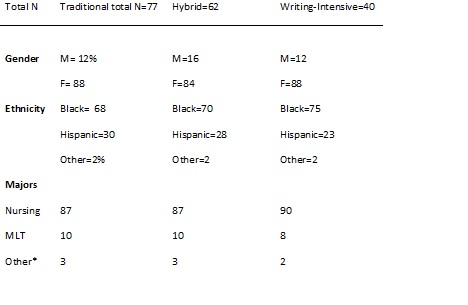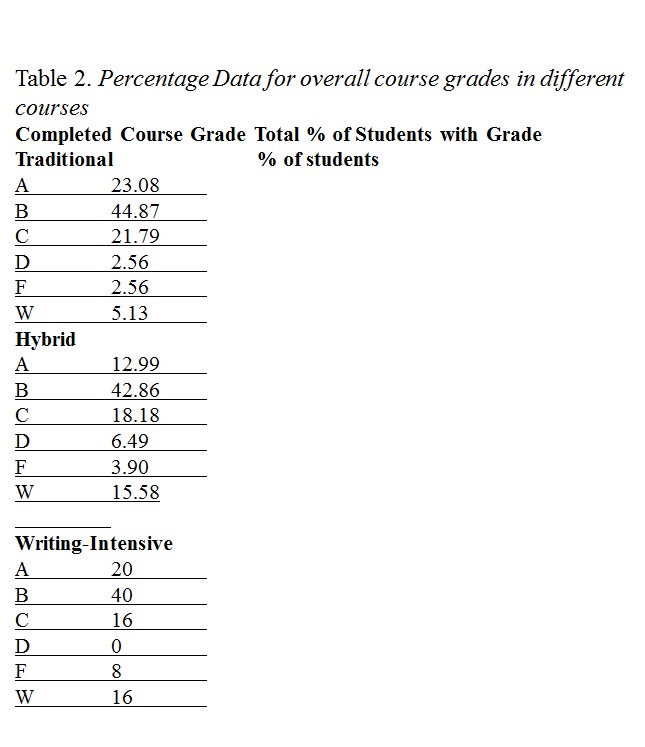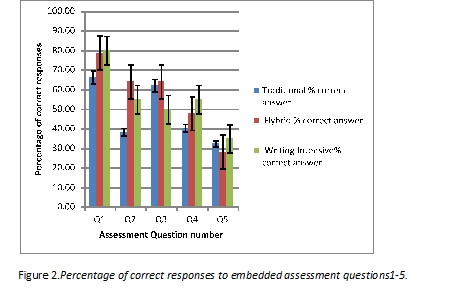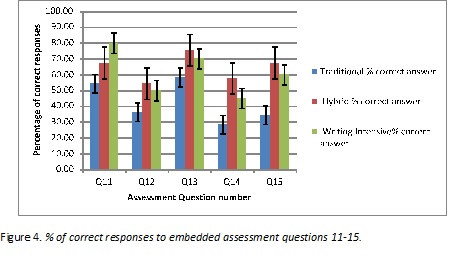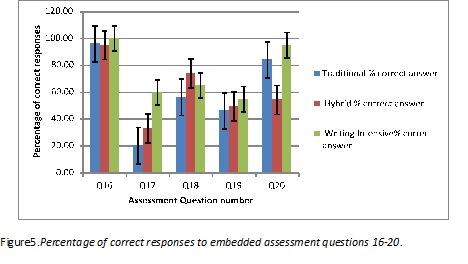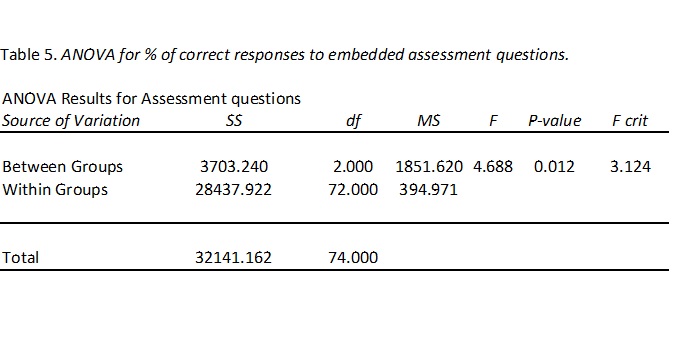Comparison of Student ‘s retention of core concepts in Traditional, Hybrid and Writing-Intensive Allied Health Microbiology and Infection Control Courses.
By: Shazia Khan
Associate Professor, Biological Sciences Department, Bronx Community College, C.U.N.Y.
Abstract: The purpose of this study was to probe best course modality for the student population of a community college taking the Microbiology and Infection Control Courses. Students’ retention of knowledge base was compared in Traditional, Hybrid and Writing-Intensive Microbiology and Infectious Disease Control courses. Students’ final grades achieved in the course and withdrawal rates were used to evaluate the comprehension of knowledge and students’ overall performance.
Additionally, students’ scores for a specific set of twenty five questions in the final lecture exam were utilized as part of the embedded assessment for retention of knowledge base, and general education proficiencies were also compared. All courses used in this study were taught by the same instructor, the difference being the lecture delivery mode. Students in all courses were provided with the same lecture notes via Blackboard. For the Traditional and Writing-Intensive (WI) courses, there were weekly in-class lectures with duration of three hours each; however, there were no in-class lectures for Hybrid courses and face to face component was three hour/week Lab session. WI students were required to do formal and informal writing assignments based on the core topics, though Lab components were exactly same for students in all courses modalities in this study. Data analysis revealed that students in Traditional courses performed much better in most aspects measured in this study, as compared to students in Hybrid and Writing-Intensive courses. Withdrawal rates were same in Hybrid and WI courses, but higher than Traditional courses. The number of students who received an overall F grade was highest in the WI courses. In terms of correct responses to embedded assessment questions, the difference was significantly higher for students in WI courses as compared to Traditional.
Introduction
Bronx Community College is one of the HSI community colleges in New York City, and, like most other institutions in this category, struggles with student retention and graduation rates. Providing services to help students stay in school and complete their education is a major challenge faced by many public institutions providing postsecondary education (Waller & Tietjen-Smith, 2009). These students struggle at various levels, such as lack of college preparedness, having to work long hours to meet their financial needs, and family issues (Mitchell, 2012).The National Center for Educational Statistics’ 6 years data (NCES, 2014) shows that only 59 % of community college students continue in the second year of college; the remaining 41%do not return to pursue their goal of achieving a higher education. This41% attrition rate highlights a serious concern of wasted resources for community colleges, when those students drop out of academic programs before completing their education. Often, it is due to the lack of learning abilities and various other reasons, such as social and economic attributes (Goldrick-Rab, 2010; Wild & Ebbers, 2002).
High attrition rates among community college students require supportive curriculum to enhance academic learning and increase retention (Rath, Rock, & Laferriere, 2013).One student retention initiative is the introduction of Writing-Intensive (WI) courses to enhance students’ ability to advance academically. It has been established time and again that students’ learning and writing capabilities decline between their freshmen year and graduation. With the incorporation of writing into the subjects of their major, the profound effect would be not only in their writing but in their overall performance in that area (Slevin et al., 1990). One part of this WI curriculum was dubbed “micro themes,” where the student must read a body of material about core concepts of the course, discuss its’’ structure, condense it while retaining its hierarchy, and write a summary. This exercise strengthens both reading comprehension and writing ability. The idea is that WI courses provide a mean of addressing the decline in student writing proficiency. The introduction of writing assignments may help promote deeper understanding of the course content. Additionally, students develop good writing skills by linking their writing proficiency with their desired field of study, which also gets them engaged in emerging issues/questions in their discipline and become active participants in the academic process (Ahlawat, Miller, & Shahid, 2011).
The demand for online learning has been on the rise in the past several years, mostly due to flexibility of scheduling. Hybrid courses add value to online learning, since they offer the valuable student teacher interaction and the ability to complete part of the work online. The flexibility in the number of hours students would have to devote to commuting to campus is also attractive, as it saves time and reduces the cost of traveling (Black, 2002; Wingard, 2004; Ernst, 2008). Hybrid or blended instruction is an ideal combination of face to face classroom format with online instruction, providing the benefits of student to instructor interaction with the convenience and flexibility of online instruction (Lamport and Hill, 2012). At Bronx Community College, a Hybrid course typically involves one-third to three-quarters of course work completed online. The question, however, is whether online courses are a reliable instructional tool to achieve learning outcomes.
The purpose of the present study was to compare the role of various course modalities (Traditional, Hybrid, and Writing-Intensive) in promoting students’ understanding and knowledge retention. The hybrid courses involved completing the lecture part of the course work online, while labs were done in class three hours per week. A WI course at BCC is characterized by 25% of the grade based on informal and formal writing. Both WI and Traditional courses have three hour lectures, face to face. WI, Traditional and Hybrid courses all have three hour face to face Lab time.
In BCC’s Microbiology and Infectious Disease Control course, most of the students are either nursing majors or Biology majors in the Medical Laboratory and Technology program. CUNY is a major contributor to the nursing workforce in New York City, and thus it is important that CUNY continues to increase the number of nursing graduates who pass their licensing exams (CUNY Master Plan 2008-2012). This course is offered as a part of the nursing program (Associate of Arts and Science degree) courses’ sequence, though some students take it while waiting to be accepted into the nursing programs at BCC or transferring elsewhere. This is the only Microbiology course students in this AAS degree program take, and with it they are expected to develop a good understanding of concepts, including microorganisms, infectious diseases and their control. These skills will enable them to maintain patient care environments that are free of infectious agents’ contamination and thus lead to prevention of disease transmission. The knowledge these nursing students gain during this course will potentially help them interact with patients in a variety of settings; for example, they develop skills to administer and analyze gram staining smears for the bacterial identification. These students must understand the significance of proper patient sample collection as well as the handling and disposal of biohazard waste. They are required to master the universal precautions and aseptic techniques to prevent disease transmission and cross contamination. The concepts of microbiology taught in this course help future nurses to see beyond their common knowledge of healthcare and to take all necessary precautions.
This study’s results are anticipated to help decide which modality works best for our students, in terms of their performance in the course and retention of core concepts. Students’ performance was assessed via their responses to 25 core concept questions, used as part of embedded assessment, along with overall course grades and withdrawal rates.
The specific considerations for the present study were:
- Retention of knowledge base evaluated through their responses to core concept questions.
- Final grade distribution for students enrolled in the three different types of courses.
- Which courses had the highest withdrawal rates?
Methodology
Based upon the core concepts taught in this course, a set of questions was used to assess students’ retention of the core content knowledge base in Traditional, Hybrid and Writing-Intensive (WI) courses. These questions are administered as part of the Lecture Final Exam in all sections of this course offered in the department.
In Traditional and WI courses students had three hours in face to face lectures each week, and a three hour weekly laboratory session throughout the semester. They were provided with PowerPoint notes through Blackboard prior to the class. Writing, often used as a mean of evaluating students’ understanding of a certain topic, is also a powerful tool for engaging students in the act of learning itself. WI classes gave students two formal writing assignments with a series of weekly short essay (micro-theme) assignments, based on core topics covered in this course; several short essay questions used made up 35% of the Final Lecture Exam Preparation Journal. The remaining 65% was based on multiple choice questions, including the aforementioned 25 assessment questions. Students were provided with clear instructions regarding the writing component, and had the opportunity to respond to the feedback in a second draft of both formal writing assignments. Each student was asked to select two topics for the two formal writing assignments that addressed a specific, significant recent epidemic. They were provided with clear rubrics that were to be used for grading their assignments, along with check sheets to be attached to the final draft for submission.
As stated previously, the benefit of hybrid or blended instruction led to an ideal schedule for many students, with the combination of face to face classroom format and online mode of instruction that allowed student to instructor interaction, but at the same time, the convenience and flexibility of an online instruction characteristic of these type of courses (Lamport and Hill, 2012). Due to the fact that the microbiology laboratory, especially classical microbiological techniques, can’t be simulated on-line, all the labs were done in person. Blackboard Course Management System was used for the delivery of course material and communication; the weekly lecture notes that were posted on Blackboard for the students in Hybrid courses were used for face to face lectures in Traditional and WI sections. All sections met on campus for weekly laboratory sessions. The engagement of Hybrid course students was accomplished with mandatory timed weekly online quizzes that could be taken any time during the week. However, only one attempt was allowed for these quizzes. Students in all courses were provided with weekly practice quizzes with unlimited attempts, which were not graded.
Data was analyzed using Excel2013. The ANOVA and Bonferroni corrected T-test was performed to test the statistical significance of differences in data for overall course grade, responses to common assessment questions, and withdrawal rates.
Results
Student Population demographics
Table1 below shows that the majority of students in these courses were female and nursing students, since, as described earlier, this course is especially designed for the Allied health programs at BCC. More recently, this course was added to Medical Laboratory Technology program curriculum as a prerequisite for Diagnostic Microbiology (BIO44), so some of the students in these classes were BIO majors in MLT program.
Table1. Student population demographics (* Transfer or non-matriculated students)
Comparison of Traditional, Hybrid and Writing-Intensive students’ overall Final grade
An overall ANOVA was performed at 95% confidence interval (p-0.05) and results for overall course grades showed that 23 % students in Traditional and 20% in WI earned grades in A- to A range, while only 13 % students in Hybrid. The number of students with B- to B+ range was also highest in Traditional courses (almost 45 %), followed by 43% in Hybrid and 40 % WI courses. 22 % of students received grades in the C range (C- to C+) in Traditional courses, 18% in Hybrid and 16 % in WI. The number of students receiving an F was highest in WI courses (8%), and 2.5and 4 % in Traditional and Hybrid courses respectively. Course Withdrawal rates were found to be almost same in Hybrid and WI courses (16%) and only 5% in Traditional courses.
Table 2. Percentage Data for overall course grades in different courses
Figure1.Percentage course grades in three types of coursesThe results of ANOVA revealed that the differences in overall grades were not statistically significant (p-value=1). This was confirmed by Bonferroni corrected T-test. Results of ANOVA for overall course grades (%) are shown in Table 3 below.
Table 3. ANOVA for overall course grades

Table 4. The results for percentage correct responses to assessment questions.
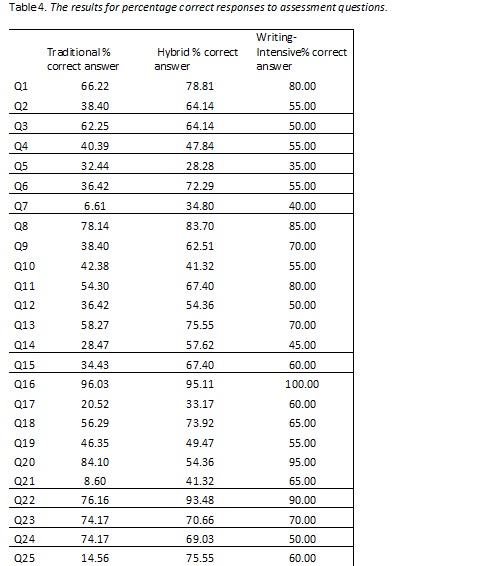
Comparison of Traditional, Hybrid and Writing-Intensive students’ responses to core concepts assessment questions
The results from responses to assessment questions (Table 4) were compared using bar graphs (Fig. 2-6) and statistically analyzed by ANOVA (shown in Table 5). Responses of students in Traditional courses were almost always lower than the ones in Hybrid or WI courses, although over all grades were higher (statistically non-significant) for students in Traditional courses, with lowest withdrawal rates.
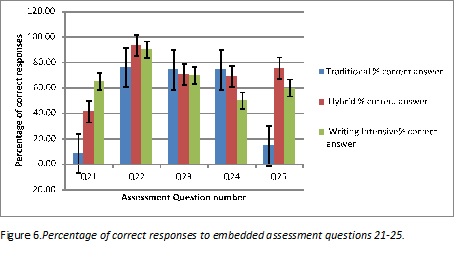
ANOVA (Table 5 below) showed that scores for at least one of the groups were significantly different from the others (p-value = 0.012). Bonferroni corrected T-test analysis revealed that there was no significant difference in responses to assessment questions for students enrolled in Traditional vs. Hybrid courses as well as Hybrid vs. Writing -Intensive. However, the difference was statistically significant for students in Traditional (mean=48) Vs WI courses (mean 64).
Discussion
A number of studies have highlighted the advantages and challenges of Traditional, Hybrid and Online courses (Black, 2002; Ernst, 2008; Wingard, 2004). This study compared Hybrid courses with Traditional and Writing-Intensive courses to help us decide what modality will work best for our students and help make recommendations to adjust the number of courses offered in each of these modalities in our department. There are varying reports regarding student learning online. Some studies suggest no statistical differences in student academic performance in Online and Traditional courses (Kraweice, Salter and Kay, 2005; Melton etal. 2009). On the other hand, a large number of studies show higher student achievement in Hybrid courses compared to Traditional (Tardai etal. 2005). According to one study, mere use of Blackboard to access course information and notes led to better grades (DeNoui and Dodge, 2006). Another study demonstrated that students performed much better in a Hybrid course than a completely online one (Collopy and Arnold, 2009).
The present study compared student success in terms of overall course grades, percentage of correct responses to a set of assessment questions based on core concepts and General Education proficiencies and withdrawal rates, in three different types of Microbiology and Infectious Diseases courses, Traditional, Hybrid and Writing-Intensive. Although there has been much interest in the use of writing in disciplinary courses, there has actually been relatively little formal inquiry into what happens in such courses once writing has been incorporated. It is a well- known phenomenon that Hybrid instruction is becoming more and more popular, due to the added advantages of being more efficient in use of space, offering flexible schedules for working adults, and reducing the time as well as the cost of commuting to and from campus. In addition to several published reports of student’s success, these benefits provide some of the strongest reasons for city colleges in urban settings, such as Bronx Community College, to offer more Hybrid courses across the disciplines. Between 2002 and 2011, the online enrollment share of total enrollment in postsecondary institutions rose from 9.2% to 32% (Allen & Seaman, 2013). A recent U.S. Department of Education Survey (Means, Toyoma, Murphy, Bakia, & Jones, 2010) concluded that hybrid and online modalities are more effective than traditional instruction. However, this study found no statistically significant difference in withdrawal rates or over all course grades for students in Hybrid versus Traditional sections. A breakdown of results for overall course grades showed that students in Traditional sections earned the highest percentage of A-to A grade range(23 %), followed by WI (20% ), while only 13 % students in Hybrid earned A- to A grades, although the differences were found not to be statistically significant. A study done by Alison etal. (2015) in an introductory course in Microbiology reached the same conclusion while comparing student outcomes in Traditional versus Hybrid courses. With the continuing development of online instructional applications, many colleges and universities have begun to offer online courses as an alternative to traditional face-to-face instruction. Sixty-seven percent of colleges and universities agree that online education is the most logical long-term strategy for their institution (Hillstock, 2005). However, there are reports that question the quality and student responsiveness to online education and reflect on the reluctance to adopt this mode of education (Yang and Cornelius, 2004). It is safe to say that just like most things in life just as there are advantages, there are also disadvantages to the online instruction delivery method. Various studies from the initial era of online instruction history reported the sense of disconnect among students in online courses due to lack of face to face instruction (Guhu, 2001; Graham, 2001), while other reports indicate large successes (Hoffman, 2002; Meyer, 2002; Kaczynski and Kelly, 2004).
Keeping in mind such issues as “What are the objectives?” and “How are the objectives to be met?” will also facilitate the decision regarding the best medium to use. Different instructional strategies may or may not result in the achievement of course learning objectives. Once the decision as to which delivery mode is most appropriate has been made, the material must be organized in such a way as to enhance learning. This may mean throwing away some current practices and replacing them with new approaches to teaching that will meet the needs of a particular student population. Evaluation and rebuilding of the course is essential, this remodeling of the courses should be based on the assessment results. (Black, G. Spring, 2002).
Writing has often been characterized as having special powers as a tool for promoting learning, as evidenced by the belief that “writing across the curriculum” should be established as a means of promoting thinking in all disciplines, “even those in which a written product is not historically valued or useful” (Peter Smagorinsky, 1995).
The Writing across the Curriculum (WAC) program was initiated at BCC a couple of decades ago, and there is a great deal of interest in incorporating writing across the curriculum at BCC since taking WI courses is a graduation requirement. However, research on the effectiveness of WAC courses has been limited. It has been reported that research on WAC often can be conducted to investigate of the effectiveness of WAC on student learning (Applebee Newell, 1981). One of the goals of this study was a responsible attempt at assessment to make links between students’ measured proficiencies and what has or has not happened to them in the full context of this WI course, compared to other modalities, especially if, as we hope, assessment is to lead to reform in curriculum design. Writing-Intensive courses provide a means of addressing declining student writing proficiency. These courses use various types of writing assignments to promote deeper understanding of the course content. The goals are to develop students as good writers by linking their writing proficiency with their desire to learn more about the field of study, engage in emerging issues/questions in the discipline, and have students become participants in academic discourse (Ahlawat, Miller, & Shahid, 2011). The results of the study can add to our understanding about how a writing-intensive course should be linked to overall learning goals for a course, what elements should be included in a writing-intensive course to accomplish learning goals and student learning outcomes, what assessment measures can be used to evaluate student performance, and how they can be linked to overall learning goals.
The present study compared the student outcomes in Traditional and Hybrid courses with Writing-Intensive courses. Data analysis revealed that there was no statistically significant difference in the withdrawal rates and over all course grades for the students in all three modalities. Comparison of the answers to 25 assessment questions revealed that although there was no significant difference in responses to assessment questions for students enrolled in Traditional Vs Hybrid courses as well as Hybrid vs. WI, the difference was statistically significant for students in Traditional (mean= 48) Vs WI courses (mean = 64). This difference may be due to the fact that students were given microtheme, essay-type weekly writing assignments based on the core concepts used to develop the common assessment questions. These essay-type questions were used as preparatory Journal for the WI part of the Final Lecture Exam, which perhaps led to the retention of knowledge base. Similar findings were reported in discipline-specific writing to learn studies by Susan Peck MacDonald and Charles Cooper (1992) and Robert Cannon (1990).
The students in Hybrid courses had to take weekly graded lecture quizzes, which might have contributed to increased retention of core concepts as compared to students in Traditional sections. So a modality that combines the writing with the resources that a hybrid course offers may lead to a synergistic positive effect. The fact that students’ overall grades were higher and withdrawal rates were lower in Traditional as compared to Hybrid and Writing-Intensive sections is also noteworthy. There is enough research supporting the potential advantages of hybrid course delivery system. Especially in this era when technology is an essential part of everyday life, there is a need to redesign traditional courses using a Hybrid model. Hybrid instructional method is a perfect integration of the conveniences of online learning and traditional face to face instruction in the learning process (Humphries 2009, Rovai and Jordan 2004, Colis and Moonen 2001). Although integrating technology into the classroom in small steps is part of a natural evolution of teaching and learning, a blended learning system includes a committed, sustained, and well thought-out implementation plan, combining appropriate technology with traditional classroom interaction, so that it leads to better outcomes for students (Garrison and Vaughan 2008; Mayers etal., 2006; Bonk and Graham, 2006). A study conducted by Riffell and Merrill (2005) also found that the hybrid course format appeared to help all minority groups in their student population perform better in the laboratory. While completely online learning might create a sense of isolation among students, blended learning provides the effectiveness and socialization opportunities of the classroom.It is critical that the determination of delivery mode for course material rest upon the question: “Will this enhance student learning?” A careful analysis of the course material must include determining what content can be used effectively online. Such items as syllabi, lecture notes and assignments can be made conveniently available to the student when placed online; additionally, analysis of course material should be founded on the question of what will actually be learned. This study suggests that identification and inclusion of the core concepts and themes hardest to grasp, incorporated through writing based on these core concepts and themes and integrated with Hybrid course modality, could provide a new tool to further promote the educational benefits of Hybrid instruction, rather than just providing a convenience to students.
References
Ahlawat, S., Miller, G., & Shahid, A. (2011). Developing a writing-intensive accounting capstone course with a research emphasis. The Accounting Educators’ Journal, 21(1), 45-58.
Allen, I. E., & Seaman, J. (2013). Changing course: Ten years of tracking online education in the United States. Babson Park, MA: Babson Survey Research Group and Quahog Research Group. Retrieved from http://www.onlinelearningsurvey.com/reports/changingcourse.pdf
Alison E. M. Adams, Shelby R., and Tinna T. (2015). A Tale of Two Sections: An Experiment to Compare the Effectiveness of a Hybrid versus a Traditional Lecture Format in Introductory Microbiology. CBE Life Sciences Education. (14)1-8.
Applebee, A. N. (1981). Writing in the Secondary School: English and the Content Areas. Research Monograph No.21 Urbana: NCTE, 1981
Black, G. (Spring, 2002). A Comparison of Traditional, Online, and Hybrid Methods of Course Delivery. Journal of Business Administration Online, 1(1), np. Retrieved January 10, 2015, from https://www.atu.edu/jbao/spring2002/black.pdf
Bonk, C. J., & Graham, C. R. eds. 2006. The Handbook of Blended Learning: Global Perspectives, Local Designs. San Francisco: Pfeiffer.
Cannon, R. (1990). Writing to Learn.In Bazerman, C.(Ed.), Reference Guide to Writing Across the Curriculum (p. 65). Parlor Press LLC, West Lafayette, Indiana 47906
Colis, B., & Moonen. J. (2001). Flexible Learning in a Digital world: Experiences and Expectations. London: Kogan Page.
Collopy,R.M.B., & Arnold, J.M. (2009). To blend or not to blend: Online and blended learning environments in undergraduate teacher education. Issues in Teacher Education, 18(2), 85-101.
DeNeui, D.L., & Dodge, T.L. (2006). Asynchronous learning networks and student outcomes: The utility of online learning components in hybrid courses. Journal of Instructional Psychology, 33(4), 256-259
Ernst, J. V., (2008). A Comparison of Traditional and Hybrid Online Instructional Presentation in Communication Technology. Journal of Technology Education, 19(2), 40-49. Retrieved January 6, 2015, from http://scholar.lib.vt.edu/ejournals/JTE/v19n2/pdf/ernst.pdf
Faaborg, J. E., Ryan, M. R.,& Millspaugh, J. J. (2004). Academic performance in Writing-Intensive courses: Can we better prepare transfer students? Natural Resources and Environmental Issues 12, p-p
Garrison, D. R., & Vaughan N. D. (2008). Blended Learning in Higher Education: Framework, Principles, and Guideline. San Francisco, CA: John Wiley and Son. DOI: 10.1002/9781118269558
Goldrick-Rab, S. (2010). Challenges and Opportunities for Improving Community College Student Success. Review of Educational Research, 80(3), 437-469. doi:10.3102/0034654310370163
Graham, T.A. (2001). Teaching child development via the Internet:Opportunities and pitfalls. Teaching of Psychology, 28, 67-71.
Guha, S. (2001). An effective way of teaching early childhood education online. Childhood Education, 77(4), 226-229.
Hillstock, L.G. (2005, August). A few common misconceptions about distance learning. Published proceedings of the ASCUE Conference, Myrtle Beach,SC.
Hoffman, D.W. (2002). Internet-based distance learning in higher education.Tech Directions, 62(1).
Humphries, J. 2009. Gauging Faculty Attitudes Toward Online and Hybrid Learning. Journal of Applied Computing. 5 (1): 28–32.
Kaczynski, D. and Kelly, M. (2004). Curriculum development for teaching qualitative data analysis online. Published proceedings of the InternationalConference on Qualitative Research in IT & IT, Brisbane, Australia.
Krawiec, S., Salter, D., & Kay, E. J 8 -13. Retrieved February 21, 2015, fromhttp://jmbe.asm.org/asm/index.php/jmbe/article/view/78/html_20 http://www.ncbi.nlm.nih.gov/pmc/articles/PMC3633137/
Lamport, M. A., & Hill, R. J. (2012). Impact of Hybrid Instruction on Student Achievement in Post-Secondary Institutions: A Synthetic Review of the Literature. Journal of Instructional Research, 1, 49-58. Retrieved February 15, 2015 from https://cirt.gcu.edu/jir/documents/2012-v1/lamport-hillpdf#content-head
LaRocque, G. (1983). Writing in the Secondary School: English and the Content Areas by Arthur N. Applebee; Anne Auten; Fran Lehr. College Composition and Communication, 34(2), 223-225. Retrieved March 20, 2015, from http://www.jstor.org/discover/10.2307/357415?uid=3739832&uid=2134&uid=2492543713&uid=2492543703&uid=2&uid=70&uid=3&uid=3739256&uid=60&sid=21106416942433
MacDonald, S.P. and Cooper, C. (1992). Writing to Learn. In Bazerman, C. (Ed.), Reference Guide to Writing Across the Curriculum (p. 65). Parlor Press LLC, West Lafayette, Indiana 47906
Mayers, P., Gialamas, S., & Cherif, A. (2006). DeVry University’s Optimize Integrated Learning System (Optimizing the Power of Onsite and Online Teaching and Learning). Paper presentation. Academic Affairs Department, DeVry University, Oakbrook Terrace, IL. Retrieved February 18, 2015 from http://www.abourcherif.com/pdfs/iOptimizeIntegrating%20Learning%20System.pdf
Means, B., Toyama, Y., Murphy, R., Bakia, M., & Jones, K. (2010). Evaluation of evidence-based practices in online learning: A meta-analysis and review of online learning studies. Washington, DC: U.S. Department of Education Report No. ED-04- CO-0040. Retrieved from http://www2.ed.gov/rschstat/eval/tech/evidence-based-practices/finalreport.pdf
Melton, B., Graf, H., & Chopak-Foss, J. (2009). Achievement and satisfaction in blended learning versus traditional general health course designs. International Journal for the Scholarship of Teaching and Learning, 3(1), 1-13.
Meyer, K. (2002). Quality in distance education: Focus on on-line learning. ASHE ERIC Higher Education Report, 29(4).
Mitchell, J. L. (2012). Beyound Academics: Challenging Issues Facing Community College Nonacademic Support Services (Doctoral Dissertation, 58). Retrieved December 15, 2014 from http://digitalcommons.nl.edu/diss/58/
National Center for Education Statistics. (NCES, 2014). Table 326.30. Retention of first-time degree-seeking undergraduates at degree-granting postsecondary institutions, by attendance status, level and control of institution, and percentage of applications accepted: 2006 to 2012. Retrieved November 19, 2014, from http://nces.ed.gov/programs/digest/d13/tables/dt13_326.30.asp
Rath, B., Rock, K., & Laferriere, A. (2013, April 1). Pathways through College: Strategies for Improving Community College Student Success. Retrieved January 1, 2015, from http://www.opp.org/docs/PathwaysCollegeStrategies_StudentSuccess.pdf
Riffell, S., & Merrill. J. (2005). Do Hybrid Lecture Formats Influence Laboratory Performance in Large, Pre-Professional Biology Courses? Journal of Natural Resources and Life Science Education 34, 96–100
Rovai, A.P., & Jordan, H. M. (2004). Blended Learning and Sense of Community: A Comparative Analysis with Traditional and Fully Online Graduate Courses. International Review of Research in Open and Distance Learning 5 (2). Retrieved January 26, 2015, from http://www.irrodl.org/index.php/irrodl/article/viewArticle/192/274
Slevin, J., et al. (1990) “Georgetown University.” Programs That Works Models and Methods for Writing Across the Curriculum. Ed. Toby Fulwiler and Art Young: Portsmouth, NH: Boyton.
Smagorinsky, P., (1995). Constructing Meaning in the Disciplines: Reconceptualizing Writing across the Curriculum as Composing across the Curriculum. American Journal of Education 103( 2 ) 160-184 Published by: The University of Chicago Press Stable URL: http://www.jstor.org/stable/1085575Taradi, S.K.
Taradi, M., Radic, K., & Pokrajac, N. (2005). Blending problem-based learning with web technology positively impacts student learning outcomes in acid-base physiology. Advances in Physiological Education, 29(1), 35-39. doi:10.1152/advan.00026.2004
Waller, L. R., & Tietjen-Smith, T. (2009). A National Study of Community College Retention Rates Segmented by Institutional Degree of Urbanization. Academic Leadership, 7(1), 1-3. Retrieved December 17, 2014, from http://knowledgecenter.completionbydesign.org/sites/default/files/294 Waller 2009.pdf
Wild, L., & Ebbers, D. (2002). Rethinking students’ retention in community colleges. Community College Journal of Research and Practice, 26, 503-519.
Wingard, R. G., (November, 2004). Classroom Teaching Changes in Web-Enhanced Courses. EDUCAUSE QUARTERLY, 26-35. Retrieved December 10, 2014, from https://net.educause.edu/ir/library/pdf/EQM0414.pdf
Yang, Y. and Cornelius, L.F. (2004). Students’ perceptions towards the quality of online education: A qualitative approach. Published proceedings of the Association for Educational Communications and Technology Conference, Chicago, IL.
Acknowledgements.The author acknowledges the contribution of other microbiology course-coordinators, all biology faculty in general, our chair, and assessment coordinators.
Tags: Bronx Community College, CUNY, Retention, Shazia Khan
Trackback from your site.





